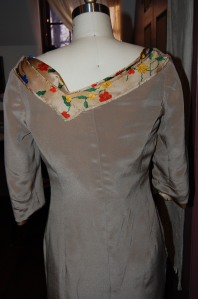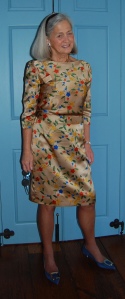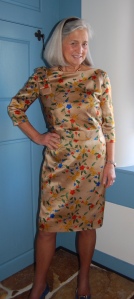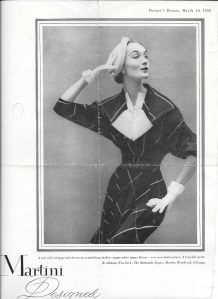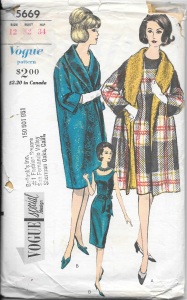March was not home to much sewing at Fifty Dresses this year. The reasons were manifold, but suffice it to say, my loved ones and I weathered through the storm. Now sweet April is here, adorned in grace and gentleness and goodness, like a balm to our collective souls. April is filled with promise.
And I have given April much to make promises about! I may have not been able to sew throughout most of March, but that did not prevent me from looking at fabric, patterns, buttons, books, and fashionable inspirations. Despite my best intentions of not succumbing to new fabric purchases, my discipline failed me and I found two silk fabrics at Britex which I decided were too special to pass by. They are so different from each other, but each one appeals to certain design penchants I have finally admitted are my weakness. One is for geometric and linear prints:
The second penchant is for whimsical, scattered florals, in multi-color. This one is especially appealing to me as it also has polka dots in its motif. Polka dots are especially difficult for me to resist.

By this point I have an extensive collection of vintage patterns, so it is rare when I find one which fills a gap for me. But such was the case with this purchase of a Vogue Paris Original by Pierre Balmain. I had not come across this pattern before, and I believe it was rightly advertised as “rare.”
I wanted this pattern for the jacket. The neckline is lovely with its small, rolled collar, and the lines in the jacket appear to be very flattering. The corded front edges are an interesting design feature which will require the right weight fabric to be finished correctly, I think. And the four buttons certainly have a prominent position for a jacket not meant to be buttoned! I will relish finding buttons for this project.
As with most of my vintage patterns, where I am never quite satisfied until I am able to assign a copyright/production date to them, such was the case with this pattern. Being a Designer pattern made it easier to narrow my search through my Vogue Pattern Book Magazines. Also, at this point I have developed a “decade” sense for styles, so I instinctively started with the mid-1960s. Bingo – the second issue from the mid ‘60s through which I looked featured this pattern. It was included in an article “Just Arrived – 33 Great Imports” in the October/November 1965 Vogue Pattern Book Magazine.

What made it especially rewarding for me was that my pink Dior coat pattern is included in the same feature. It must have been a good year.


Pink was on my mind (well, truth be told, pink is always on my mind) during the waning days of March as I zeroed in on making “birthday” dresses for my granddaughters. (Time and looming dates have a wonderful way of getting me back on the sewing track.) And yes, they are pink. However, they are also under wraps – and wrapping paper – to be opened by the birthday girls next week.
Hopefully April will not hurry away, as these months are wont to do. There are promises to keep and there is more sewing to happen at Fifty Dresses.






























